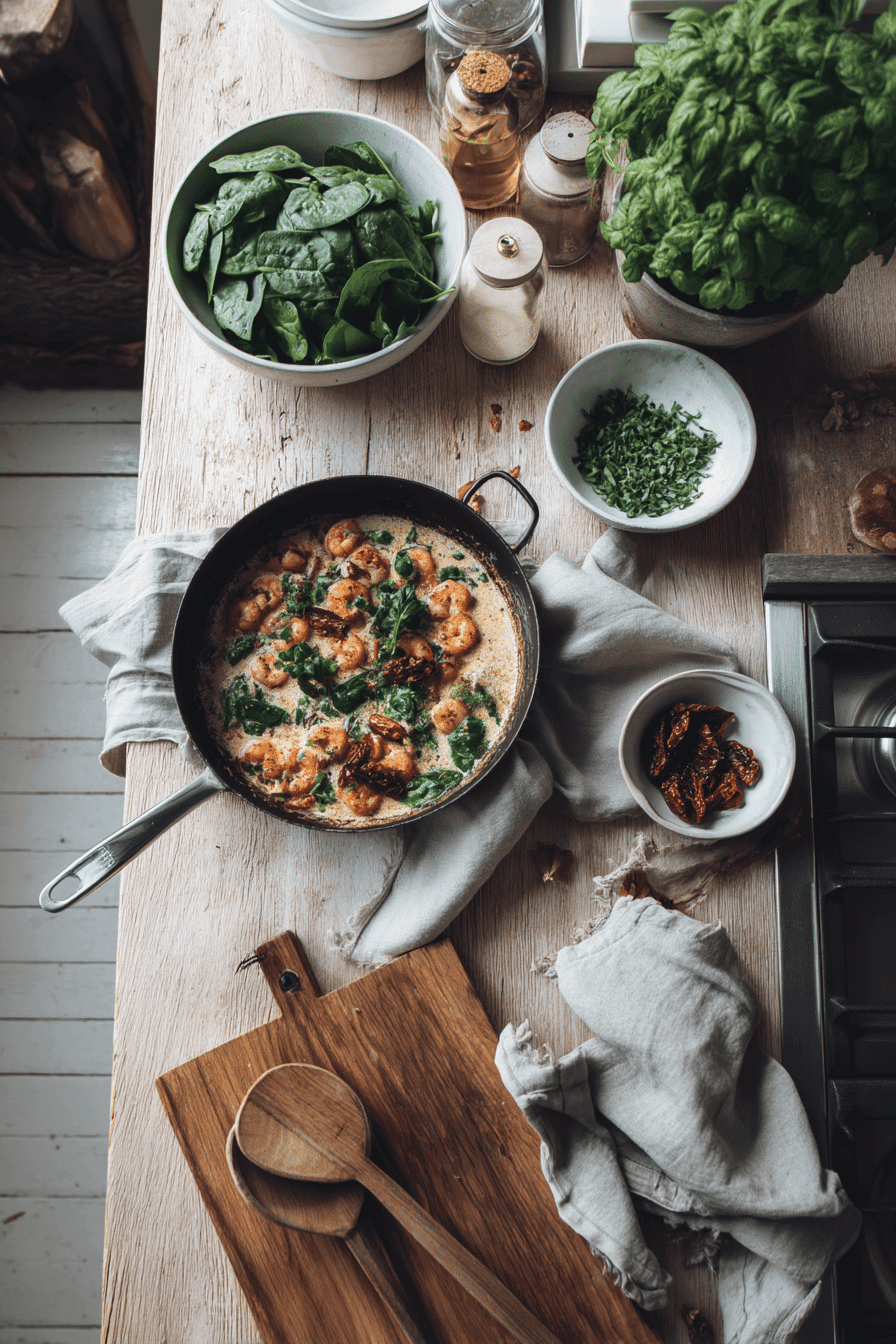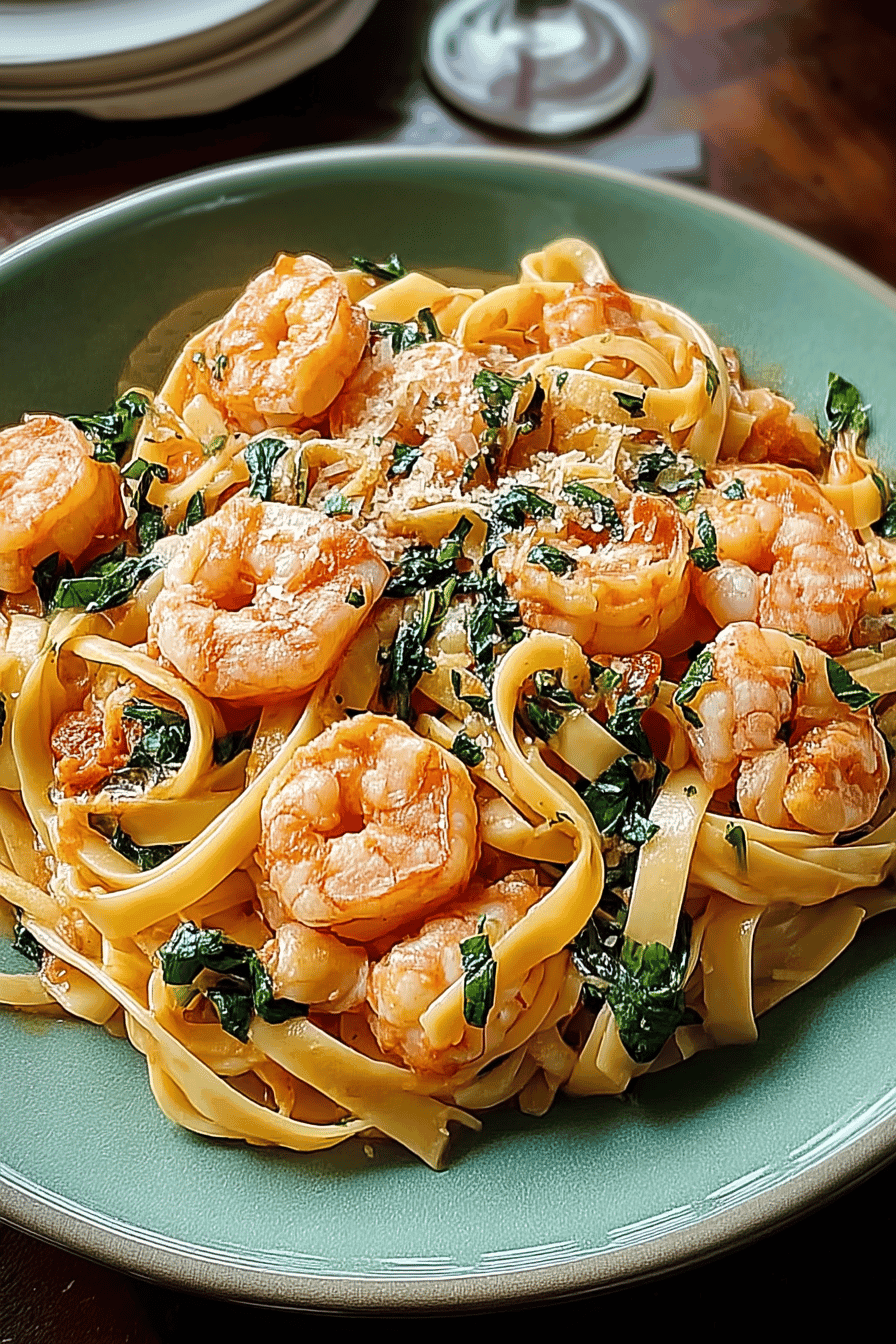Benefits and Advantages of Tuscan Shrimp Pasta
Tuscan shrimp pasta is favored for its blend of simplicity, flavor, and nutrition, making it an exceptional dish for quick weeknight dinners and special occasions alike. The recipe is straightforward, requiring just a handful of fresh ingredients and minimal preparation, ideal for home cooks of all skill levels. Shrimp provides a lean source of protein that is rich in essential nutrients such as omega-3 fatty acids and antioxidants, which support heart and brain health. Combined with fresh vegetables like spinach and sun-dried tomatoes, the dish offers vitamins, minerals, and antioxidants that enhance wellbeing.
The creamy sauce delivers satisfying richness with butter and heavy cream balanced by the brightness of lemon juice and herbs, creating a harmonious flavor profile without complexity. The use of olive oil adds heart-healthy fats, further boosting the nutritional value. The versatility of this dish allows for adjustments to dietary needs such as gluten-free or vegan versions while maintaining delicious taste and texture. Overall, tuscan shrimp pasta combines health benefits, ease, and vibrant flavors in one satisfying meal.
Jump to:
- Benefits and Advantages of Tuscan Shrimp Pasta
- Essential Ingredients for Tuscan Shrimp Pasta
- Dietary Substitutions to Customize Your Tuscan Shrimp Pasta
- How to Prepare the Perfect Tuscan Shrimp Pasta: Step-by-Step Guide
- Mastering Tuscan Shrimp Pasta: Advanced Tips and Variations
- How to Store Tuscan Shrimp Pasta: Best Practices
- Nutritional Value of Tuscan Shrimp Pasta
- FAQs: Frequently Asked Questions About Tuscan Shrimp Pasta
- What type and size of shrimp should I use for Tuscan shrimp pasta?
- Can I use frozen shrimp and spinach in Tuscan shrimp pasta?
- How can I make Tuscan shrimp pasta dairy-free without losing creaminess?
- What can I serve alongside Tuscan shrimp pasta to complete the meal?
- How should I store and reheat leftovers to keep the sauce smooth and shrimp tender?
- Quick and Creamy One-Pan Tuscan Shrimp Pasta Recipe
- Ingredients
- Instructions
- Last Step:
- Notes
- Nutrition
- Did you make this recipe?
Essential Ingredients for Tuscan Shrimp Pasta
- 1 pound (approx. 450 grams) raw shrimp (31-40 count), peeled and deveined
- 2 tablespoons butter
- 1 teaspoon flour
- 4-5 cloves garlic, minced
- 1 cup (240 ml) heavy cream
- 1/2 teaspoon lemon juice
- 1/4 teaspoon Italian seasoning (dried basil, oregano, thyme, rosemary blend)
- 1/4 cup (about 30 grams) sun-dried tomatoes, chopped or julienned (preferably packed in oil)
- 1-2 cups fresh baby spinach (30-60 grams)
- A handful of fresh basil, thinly sliced
- Salt and freshly ground black pepper, to taste
Each ingredient plays a critical role shrimp adds lean protein; butter and cream create a rich base; garlic provides pungent aroma; sun-dried tomatoes contribute tart sweetness; spinach and basil enhance nutrition and freshness; and seasoning balances the dish. Pasta, preferably fettuccine or linguine, complements the sauce beautifully but can be substituted with gluten-free or vegetable noodles to accommodate dietary needs.

Dietary Substitutions to Customize Your Tuscan Shrimp Pasta
This tuscan shrimp pasta recipe offers flexibility to fit various dietary preferences or ingredient substitutes:
- Gluten-Free: Substitute traditional wheat pasta with gluten-free alternatives such as rice pasta or legume-based noodles.
- Vegan: Replace shrimp with marinated tofu, tempeh, or chickpeas; swap heavy cream for coconut cream or cashew cream; use nutritional yeast instead of Parmesan cheese.
- Dairy-Free: Use plant-based cream alternatives and replace butter with olive or coconut oil; employ nutritional yeast for cheesy flavor.
- Low-Carb or Keto: Use spiralized zucchini noodles (zoodles) or shirataki noodles to reduce carbohydrate content.
- Additional Flavor: Enhance with herbs such as tarragon or parsley and spices like smoked paprika or crushed red pepper flakes for a subtle kick.
These substitutions allow you to maintain the dish’s creamy texture and nuanced flavors while catering to health or ethical choices.

How to Prepare the Perfect Tuscan Shrimp Pasta: Step-by-Step Guide
- Prep ingredients: Peel and devein shrimp if not done already. Mince garlic, chop sun-dried tomatoes, and wash baby spinach and fresh basil. Measure out seasonings and cream so all is ready.
- Start sauce base: In a large skillet, melt butter over medium-high heat. Stir in flour and cook for about 1 minute, whisking constantly until smooth to form a light roux.
- Add garlic: Add minced garlic to the skillet and sauté for 30 seconds until aromatic but not browned.
- Build creamy sauce: Pour in heavy cream, then stir in lemon juice, Italian seasoning, and sun-dried tomatoes. Reduce heat slightly and simmer gently for 2 minutes to thicken.
- Cook shrimp: Add shrimp to the skillet, spreading out evenly. Cook for about 5 minutes, turning occasionally, until shrimp turn pink and opaque but remain tender.
- Add greens: Stir in baby spinach and fresh basil. Cook for 2 more minutes until spinach wilts and flavors meld.
- Season: Taste and season with salt and freshly ground black pepper as desired. Add extra squeeze of lemon juice or grated Parmesan for a finishing touch.
- Toss with pasta: Combine the creamy shrimp sauce with hot cooked pasta, tossing well to coat evenly. Warm through if needed.
- Serve: Plate the pasta, garnish with additional fresh basil, and serve immediately with crusty bread or your favorite side.
This stepwise guide ensures a luscious, flavorful tuscan shrimp pasta that’s balanced and easy to prepare, with flexibility to adapt based on your pantry and preferences.
For more seafood recipe ideas, check out our collection of seafood recipes.
Mastering Tuscan Shrimp Pasta: Advanced Tips and Variations
To enrich your Tuscan shrimp pasta experience, consider adding freshly squeezed lemon juice at the end of cooking. This lifts the creamy sauce with a bright, tangy flavor that balances richness perfectly. For a bit of heat, try sprinkling smoked paprika or crushed red pepper flakes when sautéing the garlic.
Incorporate a splash of white wine while simmering the sauce to add depth and complexity. You can also add sautéed mushrooms or artichoke hearts for extra texture and a savory dimension. Using whole wheat or fiber-enriched pasta varieties can boost the dish’s nutritional value without sacrificing taste.
When cooking shrimp, be mindful not to overcook them to keep them tender and juicy; they cook quickly and become rubbery if left too long. Garnish your dish with fresh basil, parsley, or microgreens to introduce freshness and color. These advanced tips allow for personalized touches that suit a range of occasions and preferences.
Balancing flavors with lemon and herbs enhances the creamy richness of Tuscan shrimp pasta effortlessly.
How to Store Tuscan Shrimp Pasta: Best Practices
Proper storage is crucial to maintain the quality of your Tuscan shrimp pasta. Place leftovers in an airtight container and refrigerate within two hours of cooking to preserve freshness and prevent bacterial growth. Consume within 2 to 3 days for best quality.
When cooling leftovers, allow the dish to reach room temperature briefly before sealing the container to avoid condensation, which can affect texture. For longer storage, freeze the pasta in portioned, freezer-safe containers or bags for up to 2 months.
To reheat, thaw the frozen portion overnight in the refrigerator. Warm gently in a skillet over low heat or in the microwave, stirring occasionally and adding a little broth or water to maintain sauce consistency. Avoid repeated reheating to prevent the shrimp from becoming tough and the sauce from separating.
These storage techniques help keep your Tuscan shrimp pasta creamy, flavorful, and safe to eat.
Nutritional Value of Tuscan Shrimp Pasta
Tuscan shrimp pasta provides a balanced combination of protein, fats, and carbohydrates, making it a satisfying and nutritious meal option.
| Nutrient | Approximate Amount per Serving |
|---|---|
| Calories | 400–560 kcal |
| Protein | 26–31 grams |
| Fat | 30–39 grams (includes 16–18 grams saturated fat) |
| Carbohydrates | 8–25 grams (up to 7 grams fiber and 3–14 grams sugars) |
| Cholesterol | 250–380 mg |
| Sodium | 700–980 mg |
| Potassium | 425–1520 mg |
| Vitamins | High in vitamin A (1,800–5,000 IU) and vitamin C (11–41 mg) |
| Minerals | Calcium 200–230 mg, Iron 3–5 mg |
The shrimp adds lean, high-quality protein and important nutrients like vitamin B12, selenium, and iodine, supporting muscle and neurological health. Olive oil and cream deliver monounsaturated and saturated fats, respectively, while spinach and sun-dried tomatoes enrich the dish with antioxidants and vitamins. Overall, Tuscan shrimp pasta can be part of a balanced diet when enjoyed in moderate portions.

FAQs: Frequently Asked Questions About Tuscan Shrimp Pasta
What type and size of shrimp should I use for Tuscan shrimp pasta?
Can I use frozen shrimp and spinach in Tuscan shrimp pasta?
How can I make Tuscan shrimp pasta dairy-free without losing creaminess?
What can I serve alongside Tuscan shrimp pasta to complete the meal?
How should I store and reheat leftovers to keep the sauce smooth and shrimp tender?

Quick and Creamy One-Pan Tuscan Shrimp Pasta Recipe
🍤 Enjoy a luxurious and quick meal that’s ready in under 20 minutes, bringing a taste of Tuscany to your table in no time.
🥂 This creamy shrimp pasta is perfect for a delightful dinner or impressing guests with its rich flavors and simplicity.
- Total Time: 15 minutes
- Yield: 2–4 servings 1x
Ingredients
1 pound (450 grams) raw shrimp, peeled and deveined
2 tablespoons butter
1 teaspoon flour
4–5 cloves garlic, minced
1 cup (240 ml) heavy cream
1/2 teaspoon lemon juice
1/4 teaspoon Italian seasoning
1/4 cup sun-dried tomatoes, chopped
1–2 cups fresh baby spinach
A handful of fresh basil, thinly sliced
Salt and pepper, to taste
Instructions
1. Melt butter in a large skillet over medium-high heat. Stir in flour and cook for about one minute, stirring constantly, to form a light roux.
2. Add minced garlic and cook for 30 seconds until fragrant.
3. Pour in heavy cream, stir in lemon juice, Italian seasoning, and sun-dried tomatoes. Simmer gently for 2 minutes.
4. Add shrimp and cook for about 5 minutes until shrimp turn pink and opaque. Do not overcook.
5. Stir in baby spinach and basil, cooking for 2 more minutes until spinach wilts.
6. Season with salt and pepper to taste. Optionally, add extra lemon juice or grated Parmesan cheese before serving.
Last Step:
Please leave a rating and comment letting us know how you liked this recipe! This helps our business to thrive and continue providing free, high-quality recipes for you.Notes
🦐 Use medium to large shrimp for the best texture; thaw properly if using frozen.
🍅 Sun-dried tomatoes in oil enhance flavor; reserve some oil for sautéing if desired.
🌿 Add chopped artichoke hearts or mushrooms for a flavor twist and more nutrients.
- Prep Time: 5 minutes
- Cooking Time: 10 minutes
- Cook Time: 10 minutes
- Category: Main Course
- Method: Stovetop
- Cuisine: Italian
- Diet: Pescatarian
Nutrition
- Serving Size: 1 cup
- Calories: 400-560
- Sugar: 3-14 g
- Sodium: 700-980 mg
- Fat: 30-39 g
- Saturated Fat: 16-18 g
- Unsaturated Fat: N/A
- Trans Fat: N/A
- Carbohydrates: 8-25 g
- Fiber: 0-7 g
- Protein: 26-31 g
- Cholesterol: 250-380 mg







